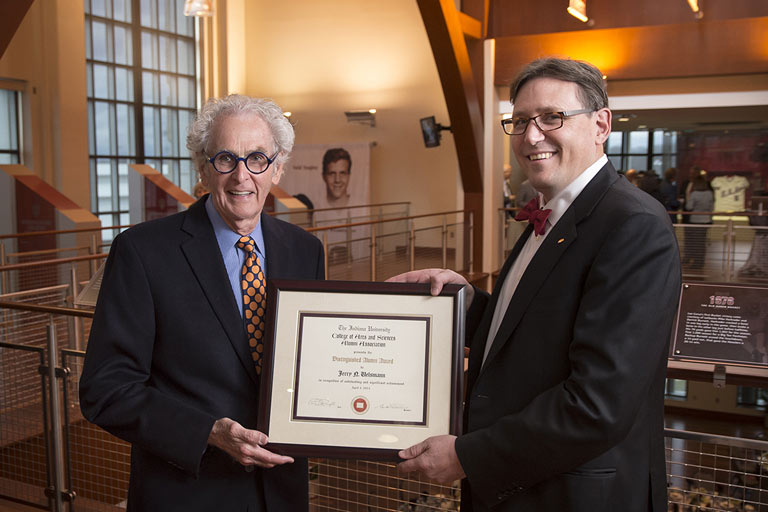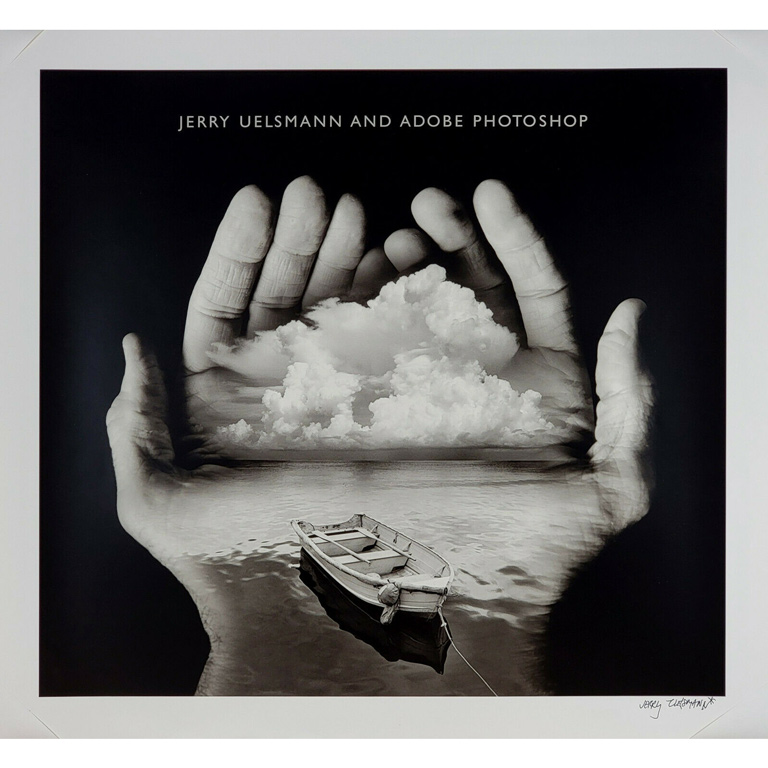Renowned photographer Jerry Uelsmann, a 1960 Indiana University graduate and recipient of the 2014 Distinguished Alumni Award, died April 4, in Gainesville, Florida. Decades before the advent of digital photo-editing software, Uelsmann’s surrealistic photomontages secured his place in the history of photography and contemporary art. From their debut at the Museum of Modern Art in 1967, Uelsmann’s photographs were exhibited in over a hundred solo shows and collected by major museums around the world.
At the time of his death, Uelsmann was professor emeritus at the University of Florida (UF), where he had taught for 38 years. In 2012, UF’s College of the Arts’ School of Art + Art History awarded Uelsmann an honorary Doctor of Fine Arts (DFA) degree. A recipient of the Guggenheim Fellowship in 1967 and a National Endowment for the Arts Fellowship in 1972, Uelsmann was a Fellow of the Royal Photographic Society of Great Britain and a founding member of the Society of Photographic Education (SPE).
Uelsmann created seamlessly composited photographs, entirely in the darkroom. The multiple exposure prints reinvigorated techniques employed by 19th-century artists who approached photography more as painting than a documentary tool. Recognizing the extent to which his images anticipated the capabilities of digital photo-editing software, Adobe invited Uelsmann to create the image for the poster announcing the launch of Photoshop in 1995. Apart from this collaboration, Uelsmann remained committed to an analog process for the rest of his life. “Let us not delude ourselves by the seemingly scientific nature of the darkroom ritual,” Uelsmann once noted; “it has been and always will be a form of alchemy.”
“I will remember him by his wonderful sense of humor, youthful spirit, and generous friendship,” recalled Arthur Liou, Herman B Wells Professor, Eskenazi School of Art, Architecture + Design. “Jerry made art approachable and enjoyable to the general audience, while maintaining an unmistakable intellectual depth.” Liou, Area Coordinator of Digital Art at the Eskenazi School, studied photography with Uelsmann at UF in the 1990s. “His generosity and support were instrumental for me in making the transition from a journalistic practice to the fine arts. I am still trying to get my work right based on something he perfected 40 years ago.”
Uelsmann traced his affinity for surrealism and his early darkroom experimentation to his IU days in the late 1950s. “Being at Indiana University and having the intense art history program they had at the time, I was introduced to all aspects of art,” he told WFIU in a 2014 interview. “Once they started showing work by the surrealists, I felt very close to that kind of image. The basic idea that the artist could invent realities that are personally more meaningful than the ones that are literally given to the eye appealed to me a great deal. And I began exploring options in the darkroom very early, some of those started when I was at IU.”
At IU, Uelsmann was a student of longtime professor Henry Holmes Smith, a champion of technological experimentation and of the medium’s potential beyond mere reportage. “I think of Henry Holmes Smith as the person who really pushed me into the deep water,” Uelsmann recalled in 2014, “If you have a serious mentor, they will on the one hand acknowledge that you have certain skills, and on the other hand, keep questioning you about what you believe in, where can this image go.”
At IU, Uelsmann also befriended Jack Wellpott, another Smith protégé who went on to shape the direction of modern photography. During his student years in Bloomington, Uelsmann also spent time exploring the Pigeon Hill neighborhood with his camera.
“The rich relationships Jerry Uelsmann formed with his mentors and peers as a graduate student at IU shaped his artistic vision and, in turn, the direction of modern art,” said Eskenazi School Founding Dean and Professor Peg Faimon.
Hailed for his technical prowess, Uelsmann considered technique merely the means to an end. “When people look at my work, if their first response is ‘how did he do it?’ I feel I’ve failed,” Uelsmann said. “I don’t mind that being the second response ... if the first response is something authentic … or that they humanistically relate to that image.
“When I’m creating my work, I try to just be honest about what is happening within me and I do find ... that the extent to which you work from your pre-conscious inner self, if you do it authentically, other people find ways of connecting with it.”
Uelsmann’s affection for his alma mater did not dim over the years. “His IU spirit will pass on to the generations to come!” said Osamu James Nakagawa, Ruth N. Halls Distinguished Professor, Photography and Director, Center for Integrative Photographic Studies. Every year at the SPE conference, Nakagawa recalled, “Jerry always told our students 'Go IU!’ and ended up singing the IU fight song.”



